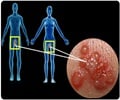Herpes simplex virus, commonly known as the cold sore virus, is a devious microbe. It enters the body through regions lined with mucous membranes—mouth, nose, and genitals—but quickly establishes lifelong viral hideouts inside nerve cells.

‘The new findings offer a model system for using gene editing in a localized way to disrupt active replication in specific sites.’
Read More..




Now, using human fibroblast cells infected with herpes simplex virus (HSV), researchers at Harvard Medical School have successfully used CRISPR-Cas9 gene editing to disrupt not only actively replicating virus but also the far-harder to reach dormant pools of the virus, demonstrating a possible strategy for achieving permanent viral control.Read More..
The team’s findings are described Dec. 2 in eLife. “This is an exciting first step—one that suggests it is possible to permanently silence lifelong infections—but much more work remains to be done,” said study lead investigator David Knipe, the Higgins Professor of Microbiology and Molecular Genetics in the Blavatnik Institute at Harvard Medical School.
Notably, the research represents the first successful instance of disrupting latent viral reservoirs through gene editing. Latent reservoirs are notoriously impervious to antiviral medications and have also proven hard to gene-edit.
The experiments also identify the mechanisms by which actively replicating virus becomes uniquely vulnerable to gene editing. These very mechanisms may also explain why latent forms of the virus are less amenable to this technique.
Specifically, the experiments reveal that the DNA of an actively replicating virus is more exposed to the Cas9 enzyme—the molecular scissors in the CRISPR-Cas9 gene-editing system. This is because actively replicating viruses have fewer protective histones that wrap around their DNA to shield it.
Advertisements
The new findings offer a model system for using gene editing in a localized way to disrupt active replication in specific sites. However, Knipe cautions, the arch-challenge of delivering gene-editing therapy to neurons—where the virus hides and enters a state of dormancy—remains to be solved, Knipe added.
Advertisements
In newborns, the virus can cause disseminated, systemic disease and brain inflammation and can be fatal in a quarter of infected babies.
Thus, one early therapeutic use of this technique could involve local and limited gene-editing of the epithelial cells in the mouth, eyes or genitals of people with established HSV infections as a way to prevent the virus from causing active outbreaks at vulnerable sites, Knipe said.“If you want to prevent corneal infections, for example, you might be able to use CRISPR-Cas9 editing in the corneal cells to prevent new infections or prevent the virus from reactivating or reduce the reactivation,” Knipe said. “People who have recurrent herpes keratitis infection of the cornea start to go blind after a while because of the reactivation and the resulting inflammation that causes clouding of the cornea.”
The advantage of limited, localized gene-editing is avoiding the widespread, possible off-target effects that might inadvertently alter the DNA of cells other than those intended.
“We still have a long way to go in ensuring hyperprecision and safety of new gene-editing tools so local editing could offer a safer, more limited first step,” Knipe said.
Werner Neuhausser, HMS instructor of obstetrics, gynecology and reproductive biology at Beth Israel Deaconess Medical Center, is co-senior author on the study. Other Harvard investigators included Hyung Suk Oh, Pierce Eggan, Magdalena Angelova, Rory Kirchner and Kevin Eggan.
Source-Eurekalert









